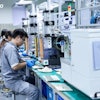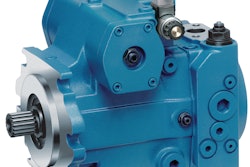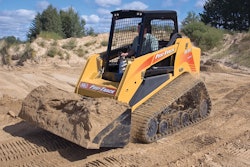Mining scalers are used in underground mines to knock down loose aggregate. When it comes to suspension systems, scalers are considered mining's most demanding application because of the tremendous downward pressure exerted when the rock breaks loose and the 90,000 lb. piece of equipment drops to the ground with the force of around 3Gs.
The resulting wear and tear on a scaler and its suspension system (which traditionally use air bags) is so severe that $100,000 in parts maintenance is generally required every year. In addition, the life of the air bags is relatively short.
When the engineering and marketing teams from Breaker Technology, Inc. (BTI) set out to develop its all-new QS Series Scalers, they knew a stable suspension system that would extend the life of the equipment and increase operator comfort would give them a huge competitive advantage.
Demands of the application
"The heading face is often so tight that the miner with conventional equipment has to keep clawing with downward pressure to loosen the rock," notes Bill Aldridge, BTI's U.S. mining manager. "And, if he doesn't release the pressure when the rock lets go, the whole unit comes crashing down, lifting one of the axles one to two feet off the ground. The air bag suspension units just weren't holding up to these demands. For our new scaler, we felt it extremely important to design and develop a suspension system that would maximize unit stability by fully absorbing the shock."
BTI's engineering manager, Brad Toole, says operator comfort is a significant issue. "We learned from users that the operator would not create any more productivity than his body could stand. As soon as the operator would start to feel fatigued, he would work the machine less. Therefore, one of our goals was to build in more operator comfort to gain more productivity for our customers."
The key was to design a platform that would be as stable as possible, a difficult task when dealing with the weight and the balance to hold it.
Further, BTI market studies indicated the need to protect the axles, as competitive units had experienced axle failures. In fact, one maintenance specialist noted that "all scalers are designed to break, it's just a matter of how long." To avoid potential axle breakage issues, BTI's design criteria specified that the axles must withstand the force of dropping to the ground from up to two feet in the air on a 90,000-lb. gross weight vehicle, or 45,000-lb. per axle.
Accumulators as "gas struts"
The challenge of designing a stable suspension system led Toole to Parker Hannifin's Hydraulic Accumulator Div. Toole had looked at existing air bag and spring suspension technology and found them lacking.
Having seen Parker's accumulator technology in other applications, Toole inquired about a suspension solution for the new QS45 Scaler. After a detailed look at the performance requirements, Parker knew it had a solution.
That solution was Parker's new Accumulator GaStrut design. This gas strut fully integrates cylinder and accumulator technologies into a compact, robust piston design in a virtually leak-free 4,000-psi nitrogen gas chamber. The term "gas strut" was applied because the cylinder acts as a strut in the suspension system with pressurized nitrogen gas serving as the energy shock absorber.
By definition, hydraulic accumulators store energy in the form of pressurized gas. The higher the pressure, the more stored energy there is in the gas. When discharged, the stored energy acts like a gas spring to absorb shock — a perfect fit for mobile equipment where there are very demanding high force loads.
The gas strut differs from traditional accumulator applications in that it combines the energy storage capability of an accumulator with the functionality of a cylinder. For this application, the cylinder serves as a strut that flexes as a regular suspension unit. The cylinder is attached by a bolted-on trunnion mount that allows for rotation. Inside the cylinder, there is a piston with a patented seal to separate the two chambers. Pressurized nitrogen gas is on one side with the rod end open to atmosphere via a filter. Nitrogen was used because of its fast response and inert nature.
"In the BTI QS Series Scaler design, the 4,000-psi pressurized nitrogen gas in each of the four gas strut units (two on each axle) is five times greater than anything else on the market," points out accumulator application engineer Mike Schubert.
Each gas strut has a rating of over 100,000 lbs. "While this may sound extreme, it is not if your scaler experiences 3G's as it drops to the ground, or when the vibratory pick (see the QS45 sidebar), scales along the mine walls to knock off debris. The reality is that you have a 90,000-lb. mobile vehicle placing three times its weight on the axles. By integrating cylinder and accumulator technology into the four gas struts, the end result is a robust, stable suspension design that combines significant load carrying with a high-pressure energy absorption capability."
No more 'rock and roll'
"This new gas strut technology," adds BTI's Aldridge, "eliminates the abuse problem. A square footprint, coupled with the stable suspension, eliminates the previous rock n' roll that causes scaler wheels to come off the ground."
Toole points out that in underground product testing no light was ever seen under the machine's tires indicating that they had achieved the goal of balance and stability. In addition, operator stress decreased, achieving the goal of prolonging peak productivity.
The increased durability of the suspension system and reduction of shock to the overall machine translates to lower maintenance cost, reduced downtime and increased equipment life.
"Generally, a scaler is expected to have a four to six-year life, and seven years of use is considered good," notes Toole. "We know that our unit will provide 50% greater operator productivity and will have lower operating costs."
The overall benefits derived from the accumulator/cylinder gas strut suspension include:
- Longer suspension life before a major overhaul. Rubber air bags can be damaged by debris during vehicle operations. The new gas strut suspension has a life expectancy many times greater than possible with air bag and spring suspensions. This directly translates to lower maintenance costs and less downtime.
In addition, Toole notes that the life of the entire machine has increased. Overall, the equipment experiences less shock due to the quick response of the nitrogen in the gas strut suspension.
- Significant reliability over rubber air bag suspension systems. With an entirely rubber surface, air bags have a much greater chance of gas permeation through the rubber. The steel cylinder acts as a barrier in the QS45 gas strut. It is also combined with a virtually leak-proof seal to ensure that the gas pre-charge is always maintained.
- Significantly lower owning and operational cost. Due to less wear and tear, the new QS45 Scaler costs 25% less per hour to operate than traditional scalers with air bag suspensions. Fuel consumption is just over four gallons/hr. vs. eight to 11 for competitive units.
- Ninety percent overall reliability. With the combination of unit balance and stability, reliability for the QS45 is currently running at 90%, comparing favorably with competitive scalers.
- Less operator fatigue due to lower vibration and noise levels (see sidebar).
- A smaller, more compact machine. Because the suspension is more compact, the overall height of the unit decreased. This is a big issue for transportation – both on the highway and when entering the workplace. The QS45 entered the mining location with no problem. According to Toole, competitive units often scrape the walls of the mine to get underground.
In the QS45 suspension, the cylinder OD is 7.5-in. with a 30-in. length when extended. This allowed BTI to come within a 3-in. clearance from the top of the strut to the undercarriage.
Cylinder length was limited because of space constraints, so a remote auxiliary gas bottle was used to ensure sufficient nitrogen gas capacity for the vehicle's initial loading.
Additional applications
Further potential exists for the Parker Accumulator GaStrut in other mining applications that require self-contained dampened suspension units. Beyond suspension applications, Schubert points to the potential of using the new combined cylinder/accumulator technology for track tensioning in bulldozers, excavators and tractors.
"There is a specific tension that needs to be maintained on the tracks of these vehicles," Schubert points out. "If the tension is not high enough, the tracks will fall off. If too great, the tracks will snap. Today, this task is often handled by large springs, which can be difficult to fit within the track widths. The single unit cylinder/accumulator combination would be a perfect fit."
Springs can be compressed, or extended, to the point of changing their tensile strength. With nitrogen gas there is no elasticity point. It continues to compress with no change in its physical properties. "So, as long as you don't exceed the working design of the unit," explains Schubert, "you always have greater flexibility in how far you can extend the gas pressure on out."
Proven in the field
"In Parker we found a partner who understood the application and the circuitry that would go with it," says Toole. "They have the expertise to take accumulator technology to new applications and custom-engineer a design that got right to the heart of what we wanted to accomplish."
Schubert notes, "with BTI we found that we shared the same philosophy … one of looking for value to sell. BTI was looking to develop and create reasons why someone would want to purchase their equipment vs. the competition. Whenever you can engineer something that so easily translates into bottom-line savings, you have really done your job well."
BTI's first customer for the all-new QS45 Scaler was one of North America's major aggregate miners. They have also had a lot of activity and interest from all of the other mining groups. This is no surprise, as BTI routinely consulted with all of the major aggregate industry producers about their needs and wants throughout the multi-year development process.
"It was that," Aldridge stresses, "along with a lot of research and finite analysis that ensured everything was right." As the QS45 Scaler has since proven in the field, it was.

















![Sa P75 I Sahr[80]](https://img.oemoffhighway.com/mindful/acbm/workspaces/default/uploads/2025/10/sa-p75-isahr80.Cn3n79HB4H.jpg?ar=16%3A9&auto=format%2Ccompress&fit=crop&h=135&q=70&w=240)